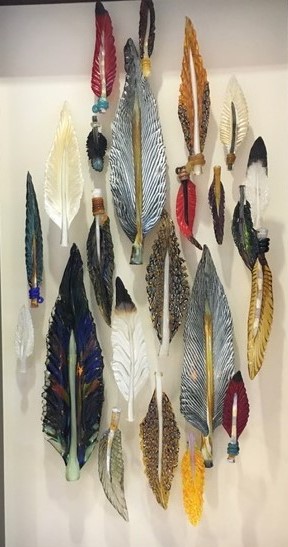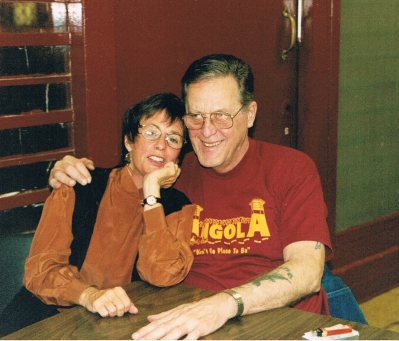
The House NEVER Loses
The most fun about writing a novel isn’t writing it but researching it. Sadly, right now it’s not possible to just jump in a car and dash off to see, hear, touch, smell, and if it’s a restaurant, taste, a place you’re writing about. Everything’s closed. Unless you happen to be writing about a casino. On Native American land. Because a federally recognized tribe has the right to regulate activities on its land independently of state control. Bingo!
And since the tribes don’t have to pander to Republican politics, they’re free to follow scientific guidelines for Covid. Temperature checks at the door, enforced social distancing everywhere and any self-obsessed cretin who refuses to wear a mask will find himself escorted off the reservation by large, intimidating Native security guards. Wearing masks. Nirvana.
Luckily, my book-in-progress (a third Blue McCarron mystery) has a scene in a casino owned by the Viejas Band of Kumeyaay Indians, so yesterday we drove up there so I could get the details right. It’s just one scene, a flashy pop concert, but I’ve never been to a concert or anything else at a casino and wanted to get the descriptive fine points. You know, like the walls, the lighting, the carpet? And I could not make this carpet up!

The Carpet
Walking on it, Blue will be forced to think of neural pathways invaded by a dark cloud of tiny flying saucers or fried eggs with blue yolks, a thought with no connection whatever to the story but that carpet is too interesting to leave out.

Glass Feathers
As are the glass feathers framed in the lobby. More pointless interior monologue about fragile, shattered feathers as a metaphor for something? Sure. But the most interesting aspect of this foray happened in a conversation with a drop-dead gorgeous descendant of the indigenous Puerto Rican Taino that provided enough information for 2 or 3 other novels. This is a problem with research. I got the carpet and feathers but also a wealth of information I wasn’t looking for!
At first Jasmene and I discussed her adult daughter’s seeming addiction to Q-Anon. The daughter has a master’s degree, shattering my assumption that educated folk automatically dismiss reports of satanic democrats kidnapping, raping and dismembering children as the production of some sick creep who’s paid handsomely to poison the minds of the not-too-bright. But this daughter is a smart, educated woman with a smart, educated mother, and she’s still terrified to take her small children out in public alone. She’s convinced that Satanist democrats will steal, defile and then slaughter them for salable organs. Jasmene’s rational arguments have no effect on her daughter, and I kept thinking this would make an interesting novel.
But then she told me about a Native activist group, No More Stolen Sisters, with which she’s involved. In Canada the sexual abuse and slaughter of First Nations women is recognized as an epidemic. In the U.S. the same epidemic quietly kills Native women and children who live anywhere near oil industry “man camps,” large tracts of rural temporary or permanent modular structures built to house the thousands of men who construct and maintain more than 190,000 miles of oil pipelines crossing the country. The carnage is particularly ghastly in remote areas of Montana and North and South Dakota where oil money rules, law enforcement jurisdictions are vague and investigations take so long that bodies decompose and vanish long before they can be found. It’s Ciudad Juárez all over again.

Activist Native women fighting to end this slaughter wear a red, painted hand over their mouths, symbol of both the official silence surrounding their missing numbers and their refusal to remain silent.
So a lighthearted trip to photograph a carpet, just something interesting to do during a pandemic characterized of necessity by boredom, changed the story I thought I was writing in a matter of minutes. Satanist democrats aren’t raping and killing children; that’s just sick QAnon propaganda. But Native women and children are being raped and killed. San Diego isn’t in North Dakota and the local Kumeyaay are running luxury casinos, not barely surviving in pitiless wastelands and subject to vicious exploitation by oil workers. But not all of them.
Across an artificial “Mexican” border thrown down by various warring European invaders, descendants of the same Kumeyaay ancestors struggle to survive in nearly inaccessible communities surrounding Tijuana and Tecate. With little water and acorns as a principal resource, most migrate to the nearby cities where they can find sporadic manual labor jobs. Illiterate and ill-equipped for success in a hi-tech 21st century, Kumeyaay women and girls in Mexico are easy prey for human traffickers engaged in the thriving border flesh industry.
That border is only 30 miles from my front door. Now all I need is a title for the book. It has to include the word, “Blue” and suggest some connection to Mexico or Native Americans or deserts. Suggestions welcome!
 Goodreads lists 250 novels set in Louisiana and the list is not complete. Tennessee Williams, Kate Chopin and Anne Rice come immediately to mind and set certain categorical standards, but in their wake are legions, including me. I wrote An Unremembered Grave after spending twenty years visiting my pal Doug in Angola, frequently as the guest of Ann Butler at her plantation B&B in St. Francisville, Butler Greenwood. I was and remain captivated by the complexity of Louisiana, its spirit and eerie allure. But for the macho and more grossly accurate version of that writerly experience, nobody can hold a candle to James Lee Burke.
Goodreads lists 250 novels set in Louisiana and the list is not complete. Tennessee Williams, Kate Chopin and Anne Rice come immediately to mind and set certain categorical standards, but in their wake are legions, including me. I wrote An Unremembered Grave after spending twenty years visiting my pal Doug in Angola, frequently as the guest of Ann Butler at her plantation B&B in St. Francisville, Butler Greenwood. I was and remain captivated by the complexity of Louisiana, its spirit and eerie allure. But for the macho and more grossly accurate version of that writerly experience, nobody can hold a candle to James Lee Burke.












 Jude’s character and becomes a subplot near the end of the tale. And the symbolic icon for that plot thread is the parting gift Luke sent to Jude so long ago – one of those music boxes with a little figurine of a dancer! (Except he’s replaced the dancer with a carved woodpecker, but, and this is so weak, there arguably was a dancer in this book somewhere.)
Jude’s character and becomes a subplot near the end of the tale. And the symbolic icon for that plot thread is the parting gift Luke sent to Jude so long ago – one of those music boxes with a little figurine of a dancer! (Except he’s replaced the dancer with a carved woodpecker, but, and this is so weak, there arguably was a dancer in this book somewhere.) Still at lunch and grabbing for straws by this point, I intrusively ask Micki if by any chance she has a heartbreaking lost soulmate story she’d like me to share with the entire world. “Not yet,” she says enigmatically, meaning, I assume, that despite three husbands the soulmate has yet to be lost.
Still at lunch and grabbing for straws by this point, I intrusively ask Micki if by any chance she has a heartbreaking lost soulmate story she’d like me to share with the entire world. “Not yet,” she says enigmatically, meaning, I assume, that despite three husbands the soulmate has yet to be lost. Halloween? Best of all possible times, when the veil grows parchment-thin and occasionally tears. Ah, that, when we suddenly see what was always there but hidden. What a shame that the ancient, ritual bow to what Freud called Das Unheimliche, the Uncanny, is now nearly buried in an array commercialized distractions.
Halloween? Best of all possible times, when the veil grows parchment-thin and occasionally tears. Ah, that, when we suddenly see what was always there but hidden. What a shame that the ancient, ritual bow to what Freud called Das Unheimliche, the Uncanny, is now nearly buried in an array commercialized distractions.











 With the retired FBI Agent who tracked Doug and then became his lifelong friend, I’m writing Doug’s story. We can’t fill in that mysterious time during the early years of his “escape,” but until days ago there was one person who could. Her name was Dojo, the woman with whom Doug lived for six years in northern CA as Walter Stevens. Dojo never knew Doug’s real identity or history until representatives of the state department showed up to terrify her with threats of imprisonment if she didn’t talk. But she couldn’t. At least not about somebody named Douglas Dennis, whom she’d never met!
With the retired FBI Agent who tracked Doug and then became his lifelong friend, I’m writing Doug’s story. We can’t fill in that mysterious time during the early years of his “escape,” but until days ago there was one person who could. Her name was Dojo, the woman with whom Doug lived for six years in northern CA as Walter Stevens. Dojo never knew Doug’s real identity or history until representatives of the state department showed up to terrify her with threats of imprisonment if she didn’t talk. But she couldn’t. At least not about somebody named Douglas Dennis, whom she’d never met!
 But I knew Doug wanted her to be protected from whatever pain still pinged from his long-ago and necessary deception. (Necessary because if she’d known who he was she would have gone to prison for harboring an escaped criminal when his cover was blown.) So, no unethical use of dachshunds.
But I knew Doug wanted her to be protected from whatever pain still pinged from his long-ago and necessary deception. (Necessary because if she’d known who he was she would have gone to prison for harboring an escaped criminal when his cover was blown.) So, no unethical use of dachshunds.



 The highest office in the United States may soon be so defiled by the presumptive presence of a vicious, sleazy conman that the office will no longer exist. Donald Trump will never be President of the United States because his presence obliterates all meaning inherent in the office. But he will, if not stopped, utterly destroy the United States.
The highest office in the United States may soon be so defiled by the presumptive presence of a vicious, sleazy conman that the office will no longer exist. Donald Trump will never be President of the United States because his presence obliterates all meaning inherent in the office. But he will, if not stopped, utterly destroy the United States. But apparently some percentage of (white) women also hate women, at least insofar as they were willing to sacrifice all integrity in the interest of imagined personal financial gain or protection from Islamic terrorists. (Terrorists from other religions are okay.) That any woman cast her vote for a pathetic, predatory, narcissistic joke of a man, is insane.
But apparently some percentage of (white) women also hate women, at least insofar as they were willing to sacrifice all integrity in the interest of imagined personal financial gain or protection from Islamic terrorists. (Terrorists from other religions are okay.) That any woman cast her vote for a pathetic, predatory, narcissistic joke of a man, is insane.
